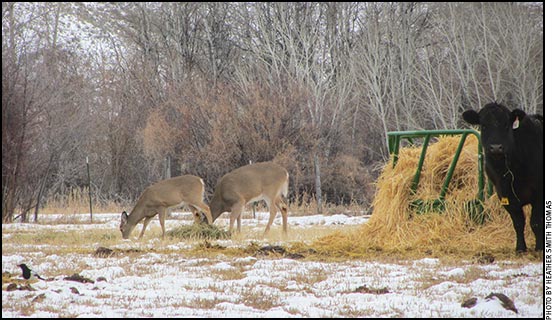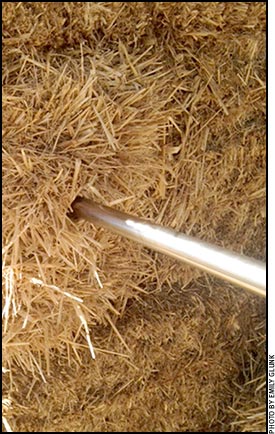
Signs of acute nitrate poisoning include labored breathing, muscle tremors or twitching, staggering gait/incoordination, weakness, etc. These animals generally have blue mucous membranes, due to lack of oxygen in tissues; fast breathing; high pulse rate; weakness and other signs of oxygen shortage because red blood cells lose their ability to carry oxygen.
Nitrate Poisoning in Cattle
Nitrate levels in cereal hay/straw need to be checked by producers before feeding it to cattle.
Consuming forage with high nitrate levels can be dangerous for ruminants, says Russ Daly, Extension veterinarian and associate professor at South Dakota State University.
Signs of acute nitrate poisoning include labored breathing, muscle tremors or twitching, staggering gait/incoordination, weakness, etc. These animals generally have blue mucous membranes, due to lack of oxygen in tissues; fast breathing; high pulse rate; weakness and other signs of oxygen shortage because red blood cells lose their ability to carry oxygen.
“Body cells are unable to work properly if they don’t have oxygen. The animal dies of suffocation, but from the inside. The ultimate effect depends on how much nitrate the animal consumed in feed and how accustomed they are to eating feed with higher-than-normal nitrate levels,” he explains.

“If there is any chance there might be a problem, it is safer to confirm nitrate levels through testing, rather than simply guessing. Knowing actual levels in feed enables a producer to manage those feeds by diluting them in the proper proportion with other feed. Sometimes we do encounter really high levels that are just too high to safely dilute,” says Russ Daly.
You may notice animals with signs of nitrate poisoning, but, in most cases, you just find the animal dead. “They usually consume enough nitrates to die fairly rapidly. They don’t last very long without the ability to carry oxygen in the blood,” says Daly.
“We were taught in vet school that one of the clinical signs is brown-colored blood, but it’s not often that we find the animal in time to check this. You might see this in an animal that just died or in the last stages before dying,” he says.
Lower levels of nitrate poisoning — that don’t kill the animal — may cause abortion in pregnant animals. Daly says the reason for this is thought to be that the fetus has a high oxygen demand. If the mother’s blood loses its full capacity to supply oxygen to the fetus, it may die and be expelled. This can occur several days after the cow was exposed to the nitrates.
“Abortions associated with high nitrates are hard to diagnose, however, since abortion can be due to many causes. It’s challenging for veterinarians trying to diagnose nitrate poisoning because the body continues to metabolize nitrates after it dies. Bacterial contamination can also enter an aborted fetus, and metabolize the nitrates. If a person is simply looking for nitrate levels in the body, it can be frustrating,” he says.
There are references in the literature about chronic nitrate poisoning, but this is not well documented. It is suspected that chronic exposure to nonlethal levels of nitrates lead to poor performance, poor milk production and/or more susceptibility to other diseases, says Daly, however, there just isn’t enough solid information to be sure.
Diagnosing nitrate poisoning is often based on equating high nitrate levels in the feed to clinical signs (or mortality) in the animals that consumed the feed, explains Daly.
The important thing is to check feed sources and test for nitrates.
“If there is any chance there might be a problem, it is safer to confirm nitrate levels through testing, rather than simply guessing. Knowing actual levels in feed enables a producer to manage those feeds by diluting them in the proper proportion with other feed. Sometimes we do encounter really high levels that are just too high to safely dilute,” says Daly.
“In most cases, however, high-nitrate feeds can be utilized in some fashion, either by diluting, ensiling or feeding to lower-risk animals. With some levels you are safe to feed it to younger animals rather than to pregnant cows,” he clarifies.

Editor’s Note: Heather Smith Thomas is a freelance writer and a cattlewoman from Salmon, Idaho.






